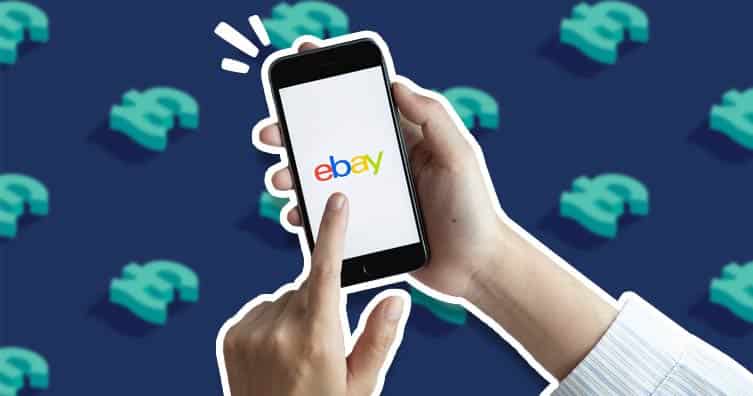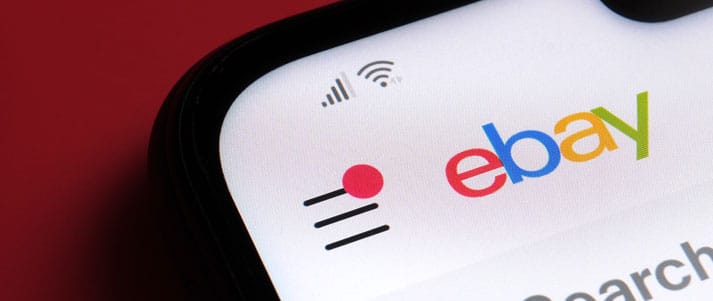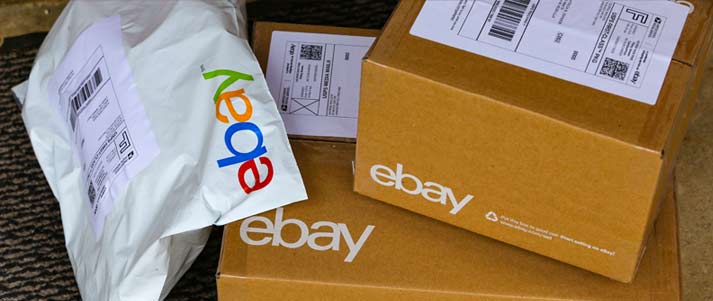16 profitable eBay selling tips
Looking to make a tidy income as an eBay seller? Here's how to sell on eBay and make the most money from listings.

Credit: Natee Meepian, paitoon – Shutterstock
Whether you're looking to set up your own online business or just want to shift some old belongings, selling on eBay can be a great way to make some extra cash.
But, whatever your intentions, it's best to learn the ropes on how to sell on eBay before getting started so you can be sure you're not missing any tricks, and know that you're on top of all the eBay fees.
We've crammed as much info as we can into this guide. When you're done reading it, you'll have all the advice you need to start making money on eBay.
How to make money on eBay
Here are the top 16 ways to maximise your profits by selling things on eBay:
-
Know the best things to sell on eBay
Whether it's old textbooks or your Pokémon card collection, before putting something on eBay, you should take some time to decide whether what you're selling is in the right condition.
You might be keen to start making money on whatever you can get your hands on. But, if you make the mistake of selling items that aren't in good condition or are missing crucial parts, you could get bad reviews which will make it harder to sell other things on eBay.
If you're looking for the best things to sell on eBay, use Terapeak Product Research to find the hottest items. This will give you an idea of what products sell.
Try thinking seasonally, too – you're not likely to get many bids on a pair of sunglasses in the middle of winter, so put them somewhere safe until the time is right. Chances are you'll make a lot more money if you can wait until they're in more demand.
-
Buy cheap things to sell at higher prices
As well as selling items you no longer use on eBay, it's also worth looking for low-priced things to sell at higher prices.
Be it at your local charity shop, a car boot sale or even on eBay itself, there are loads of places to find great deals on products.
There's a risk you could lose money doing this if you're unfamiliar with how much a particular product sells for on eBay, so it's best to do some research first. Our guide to upselling is a good place to start.
But, if you're confident that a seller has underestimated an item's value, it's a good opportunity to buy it, sell it for the price you think it's worth and (hopefully!) earn a profit from it.
For example, we interviewed a student who picked up items at a car boot sale and sold them on eBay for 10 times what she bought them for.
-
Improve your eBay profile

Credit: Ascannio – Shutterstock
The best way to get started as a seller on eBay is to become a buyer first. This way, other users can see you have an eBay history and recognise you're trustworthy.
Even if you purchase a couple of small items for a few quid each, paying for the items promptly and taking the time to give feedback (positive if possible!) can build up your eBay presence and get you a good buyer rating.
Another important step is choosing your username. Remember that whatever you choose will effectively be the name of your mini business, so lewiscapaldifan103xx probably won't instil a huge amount of confidence in potential buyers.
We'd recommend either going for something simple and professional, like a variant of your name, or a name that's relevant to the kind of things you plan to sell (this might make you easier to find in eBay searches too).
-
Research eBay's fees
Before you start making money on eBay, you first need to work out how much an item is worth and how much it will cost to sell. Obviously, you want to make a decent profit, but there are some additional costs applied when selling on eBay that you need to be aware of.
The eBay Fee Calculator is a nifty tool that works out how much you'll pay for each sale, based on what you list it for and how much it eventually sells for. Try running your item through this to see the profit you'll make.
What are eBay's fees?
- You're allowed to list 1,000 items per month free of charge – after that, you'll be charged a 35p fee per item.
- There are extra charges for optional listing upgrades, like adding a subtitle or listing your item in multiple categories.
- 12.8% of the first £2,500 of the total transaction (including postage) goes to eBay, plus £0.30 per order.
- Depending on how much you sell on eBay, you might need to pay tax. Check out HMRC's badges of trade, and if you meet some or all of them, you may need to pay tax.
These are some possible fees you may be charged for your eBay shop. eBay's private seller page has details on all their charges, which will vary depending on what you're selling.
If the costs of selling on eBay seem a little steep to you, check out our guide to making money on Amazon to see how the fees compare. -
Look out for eBay seller promotions
From time to time, eBay runs promotional offers for private sellers. Look out for these as you'll likely be sent an email with a link to activate them. If you can wait until these offers come around to sell your higher-priced items, you could save a fair amount of money on seller fees.
The offers can include paying reduced fees (sometimes as little as £1 per listing!).
To use the offers, look on your seller account page on eBay and find the section containing current promotions. Next to each offer, it will either say 'Available', in which case it's been applied to your account, or you'll need to click a button to activate it.
Or, keep an eye on our student deals section. If and when the offers are running, we'll feature them.
-
Charge the best price for your item

Credit: bbernard – Shutterstock
When you've decided on an item to sell, use the eBay advanced search tool to discover how much similar items have been selling for lately. You can search for whatever you want to sell and tick the 'completed listings' box to see heaps of similar items and the prices they sold for.
For some items, like CDs and DVDs, you can find out how much they're worth by getting quotes from other second-hand selling websites like musicMagpie.
If you can scan your item's barcode, you should get a pretty accurate valuation. You can then add a bit onto this amount as your selling price on eBay (unless you're offered a really good price for it, in which case you could sell directly to that site instead).
Also, make sure you correctly price the postage, or you could end up out of pocket. Royal Mail's price finder will tell you how much postage will cost, so you can add this to the listing. But remember that you do have to pay an eBay fee on the total transaction, including postage!
Note that high postage fees can put some sellers off, so we'd recommend adding the cost to the price of the product itself so you can offer free postage. This will give your items a "Free Postage" tag in the search results. And since buyers can filter out items that don't offer free postage, your products will be seen by way more users.
-
Start bids low to catch the attention of buyers
It might be tempting to give your listings a high initial price, but starting your bids at 99p (or similar) could get you a better sale in the long run.
A low starting bid will catch the attention of more potential buyers and encourage a competitive bidding war as the item reaches its last day of bidding.
However, please note that this tip doesn't apply to niche products. If you're selling something that only an avid collector would be searching for, don't set the initial bid too low as you're less likely to get a lot of bids on these items.
You can always add a minimum price (the reserve) if you're worried about getting a rough deal, which means the item won't be sold unless it reaches this minimum required amount.
-
Take good photos of the items you're selling
A photograph of the item you're selling adds maximum credibility. An eBay user is much more likely to continue bidding if they're confident they can see an accurate representation of what's on offer.
If there are extra components to the item you're listing, include them in the photo. We're talking boxes, instruction manuals, batteries and whatever else you've mentioned in the description.
You don't need an amazing camera, but use the macro mode (if you have one) and autofocus, both of which will work wonders for close-up shots.
Natural daylight is key to getting clear, high-quality photos. But, if you're in a dimly lit room, adding a little extra lighting (like a desk lamp) can make a big difference. Just make sure you avoid any shadows.
Also, remember that you can upload 24 photos to a listing for free.
-
Launch auctions during eBay's peak times

Credit: samritk – Shutterstock
Before you jump straight in and post your listing, take some time to think about when you should open the bidding.
Generally, the best time to end any auction is on a Sunday evening. This has been proven to be when most casual buyers go for a browse, so it's the time that auctions start to heat up.
If you're going for the maximum 10-day auction (which is always the best option as it increases the chances of getting more bids), list it on a Thursday evening to increase your exposure to potential buyers.
As mentioned earlier, if you're selling a themed or seasonal product, think about what time of year would be best for it to go on eBay.
For example, the start of October would be the perfect time to start listing any fancy dress items you have as people start searching for their Halloween party outfits online.
-
Write convincing product descriptions
Now for the hard part: writing the descriptions that will sell your product. Take your time to do this, as a good description can make or break a deal.
eBay allows you to use up to 80 characters in your title, so make the most of it. Make it clear and concise, and use plenty of keywords to help make your item as easy to find as possible.
How to write eBay product descriptions
- Avoid spelling errors – typos can limit how easy it is to find your listing on eBay searches.
- Make the description concise, informative and accurate, highlighting the key features and selling points.
- Use popular eBay acronyms like VGC (very good condition), BN (brand new), BNIB (brand new in box) and BNWT (brand new with tags).
- Be honest about all issues and defects. Buyers can leave bad reviews and ask for their money back if the item isn't in the condition you described.
- If relevant, mention how often the product's been used or why you're selling it.
- Your items will command a much higher price if you've got all the packaging, tags and instruction books.
- Invite potential buyers to contact you if they have queries.
- List all of your terms and conditions, including the payment situation, postage and packing, and refunds.
- Try using the HTML function to make your description look more snazzy (there are free online courses to teach you). But if you're still struggling, you can use simple eye-catching fonts and colours instead (while still keeping it professional, of course).
- Make sure you list your item in the right category. If it's not immediately obvious, search for what you're selling and see where similar products are generally listed.
- If you're selling a lot of similar items at once, link to your other sales in your description.
- For ideas on how to word your descriptions, look at how top sellers describe their items that sell for high prices.
-
Never do shill bidding on eBay
'Shill bidding' is when you bid on an item with the intention of increasing its price/search ranking or making it look more desirable, rather than because you actually want to buy it. This is prohibited, so neither you nor your friends or family members should ever bid on your auctions.
There are systems in place to spot this and prevent it from happening on the site. For more details, read eBay's policy on shill bidding. They've got super clear guidelines on it, so if you're unsure about it, the info on their site can put your mind at ease.
-
Increase your eBay selling limits
When you first start selling on eBay, you can usually only list 10 items up to a value of £650. Before you're allowed to add more items to your eBay store, you have to prove that you're a good seller by sending your items quickly, communicating with the buyers and collecting positive feedback.
To increase your limits, you can hit "request selling limit increase" on your profile. eBay will then decide if they want to give you a few more listings. But you can only do this once a month, so it can take a while to build up your to a decent number of listings. Especially if you're selling high-value items, you could reach your limit pretty quickly...
If you want to speed up the process, you can email the support team. They're often happy to increase your account's limits sooner if you have good feedback and sell your items at a reasonable price. We've tried this ourselves and increased our limit to over 1,000 items per month in just a couple of weeks!
-
Maintain contact with buyers on eBay
Once your sale has gone through, be sure to send a confirmation email to your buyer as soon as possible and invoice them for the full amount, including the postage charge.
You should then send them another email once you've received their payment and when you've dispatched the item. We know this sounds like a lot of emails, but buyers appreciate being kept in the loop and if you're too quiet there's a chance they'll get suspicious and report you.
Make sure you also dispatch the item as promptly as possible and be careful not to be too ambitious with your 'handling time' declaration. If you estimate that you'll take two days to dispatch the item but end up missing that self-imposed deadline, you could receive a negative review and the buyer may ask eBay for a refund.
When your customer has received your product, remember to give them some lovely feedback. It's how the eBay world works, and as the saying goes: what goes around, comes around.
-
Package items in a large envelope to save money
If the items you're selling can fit in envelopes, this can save you money on getting the goods to the winning bidder.
As long as the envelope's within the Post Office's guidelines of a large-letter size (35.3cm x 25cm x 2.5cm), you can avoid the added costs of selling parcels. Keep in mind that there are weight limits for large letters, so always check with your local Post Office if you're paying the correct postage.
Of course, not all items will fit in envelopes. But if you're selling something small like CDs, jewellery or thin items of clothing, it can cut the cost of post and packaging (which will make your listing look even more appealing to buyers).
-
Always get proof of postage when selling on eBay

Credit: Ascannio – Shutterstock
Send every item you sell by recorded delivery – or at least get proof of postage. Particularly because, unfortunately, there are eBay buyer scammers out there who cause trouble by telling eBay that items haven't been received, even when they actually have been delivered.
Make sure you're armed with proof in case you need to fight your corner.
-
Send items with a hand-written note
Adding a personal touch to your deliveries makes a massive difference. If you write a little note to say thank you to the buyer for their purchase, it gives them an insight into the person behind the sale, which will mean a lot more to them than an anonymous eBay username.
If you're selling something like vintage clothes, you could give a little info about the back story of the item in the note with details like when you first bought it, where it was from and your reasons for selling it.
It only needs to be a couple of sentences (a whole letter would be a bit over the top), and it might even be repeating things from the product description. But, make an effort to present it nicely, and you can be confident that your eBay customers will appreciate it.
It could even lead buyers to feel more inclined to leave you a positive rating on eBay and buy from you again.
Hopefully, you should now be equipped with the skills and know-how you'll need to succeed as an eBay seller. Good luck!
For more ideas on how to start raking in the cash, head over to our make money quickly guide.








